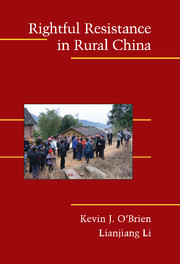Book contents
Appendix A - Who Leads Rightful Resistance?
Published online by Cambridge University Press: 05 September 2012
Summary
Who tends to lead rightful resistance? This question cannot be answered directly or with confidence, although it has been noted that organizers of rural protests are often male and demobilized soldiers (O'Brien and Li, 1995: 768; Bernstein and Lü, 2003: 143; Yu Jianrong, 2001: 565). Based on his fieldwork in Hunan, Yu Jianrong (2000; 2001: 565; 2003: 2) also found that “spokesmen for peasant interests” (nongmin liyi daiyanren) were typically thirty to forty-five years of age, former migrant workers, neither Party members nor village cadres, who had lower middle school education or more and enjoyed an upper middle level of family income. Others have presented evidence that, among the aggrieved, men, older people, and those with higher incomes and/or a cadre in the household are most likely to appeal to higher authorities (Michelson, 2004). Minzner (2005), citing a study by Zhao Shukai (2003) of nearly two hundred petitioners who registered their complaints with Farmer's Daily in 1998 and 1999, notes that visitors to letters and visits offices in Beijing tended “to be men, 35–60 years old, often with a middle-school (junior high school) degree.” Zhang's (2005: 44) research on peasant leaders in three Hunan counties emphasizes older men in their sixties and seventies or middle-aged peasants in their thirties and forties, all of whom had worked for the government previously but who were not presently employed in the state apparatus.
- Type
- Chapter
- Information
- Rightful Resistance in Rural China , pp. 135 - 138Publisher: Cambridge University PressPrint publication year: 2006

